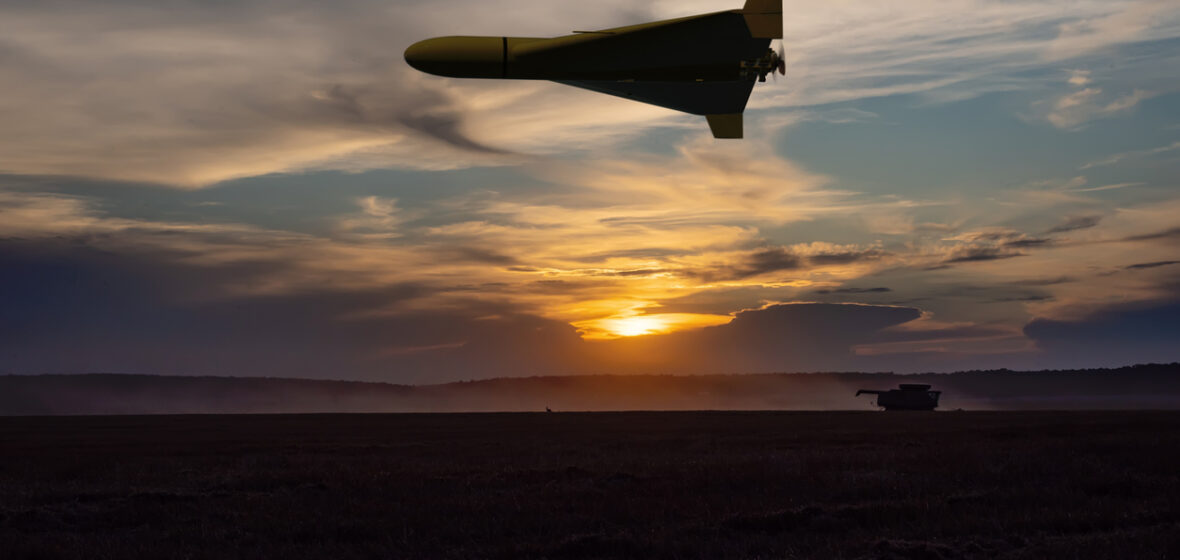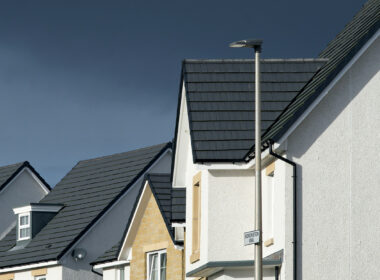As nations globally face pressure to spend more on military defence and offence, and as Australia confronts a potential US withdrawal from AUKUS, there is impetus both here and abroad to invest in autonomous systems to monitor, deter, and protect on land and undersea.
Australia leads its international counterparts in regulation of drones and counter-UAS measures, but perhaps this is to our detriment, since Australian drone and counter-drone technology vastly outpaces the legislation around countermeasures, unmanned platforms, and recognising civilian and commercial drones as potential weapons of warfare.
Australian technology impresses, while legislation lags
Paul Cenoz, General Counsel at ASX-listed, Sydney-based DroneShield, explains the company was founded in 2014 and presently has more than 25,000 shareholders.
Cenoz tells LSJ Online, “When drone technology first appeared, it was evident that it could be weaponised or used for nefarious surveillance and intelligence gathering purposes. This was a niche problem that DroneShield sought to specialise in and address through the work of our skilled engineers pioneering ground-breaking techniques.”
“DroneShield is a proudly Australian company, with nearly all of our proprietary technology developed domestically. Australia’s standing internationally as a trusted ally including among the five eyes, makes us a trusted partner globally for many of our international clientele. We have an office in the U.S with plans to expand our physical footprint in Europe to meet market demands for our products. Australia punches well above its weight when it comes to defence innovation.”
In October 2023, DroneShield technology was part of the Australian Government’s military assistance package to Ukraine, which saw around $10.4 million of DroneShield equipment donated.
In Australia, military drone operations are primarily governed by the Defence Act 1903 (Cth), which restricts the use of military force domestically without ministerial approval. While the Australian Defence Force (ADF) can use drone detection systems, current legislation limits their ability to employ countermeasures against drone threats on Australian soil. Specific regulations for civilian drone use, managed by the Civil Aviation Safety Authority (CASA), also apply to military drone operations, particularly regarding safety and airspace restrictions.
The ADF uses drones for Intelligence, Surveillance, Target Acquisition, and Reconnaissance (ISTAR) in land force operations, but countermeasures against threatening drones is complicated by CASA requirements.
As David Goodrich, CEO of Anduril Australia, wrote for the Australian Strategic Policy Institute (ASPI) in June, “legislation, not technology, is the biggest problem for ADF drone defence.”
Under the Defence Act 1903, the defence force does not have statutory authority to use drone countermeasures domestically, even though civilian agencies such as the Australian Federal Police can do so under given circumstances. The ADF requires state government permission to take countermeasures against a drone and then must do so under the supervision of a CASA- or Airservices Australia-delegated law enforcement officer.
Were an attack of the nature of Ukraine’s Operation Spider’s Web to take place in Australia – that is, commercial, relatively cheap drones targeted en masse at air force hangars – Australia would be highly vulnerable to losing key aircraft used for defence, humanitarian, and disaster response.
The Defence Issues Paper 2014 stated:
“Today, Australia’s defence policies must deliver an ADF that can effectively protect Australia from direct attack, of whatever form, and is also able to secure and advance our interests. These include the protection of our trade routes and prevention of non-geographic threats, such as those from cyberspace, terrorism, transnational crime, people smuggling, and illegal fishing.”
More than a decade later, the same attitude could well be applied to rapid technology shifts in drones and counter-drones. The Defence Act 1903 is designed to address hostile attacks from foreign entities, rather than allowing for defence countermeasures domestically.
Cenoz says, “There are significant differences through every jurisdiction regarding drone usage as well as drone detection and counter drone regulations. The counter drone space has been a hot topic due to the continuing and growing threat posed by drones. Therefore, we see an interest in tightening drone usage laws while relaxing laws regarding detection and mitigation of drones. However, I don’t believe that the laws globally regarding counter drone measures have caught up to the risks posed by them in Australia, as well as globally.”
Australian regulations
The Civil Aviation Safety Authority (CASA) is the regulatory power for drones in Australia. There are general rules applicable to recreational and commercial drones, while military drones have specific regulations. Generally, drones have to be registered with CASA and operators must hold a Remotely Piloted Aircraft (RPA) license. Amongst other regulations, there are restrictions on maintaining the drone within the operator’s line of sight, flying no higher than 120 metres, and keeping a 30-metre distance from people.
Presently, airspace is managed by both civil and military authorities. Airservices Australia provides air traffic control services at civilian airports and airspace. The Department of Defence, via the Royal Australian Air Force (RAAF), manages military airfields, airspace, and special use airspace.
In December 2024, a new piece of privacy legislation aimed at drones came into effect: the Privacy and Other Legislation Amendment Act 2024 (Cth). This falls into the remit of the Office of the Australian Information Commissioner (OAIC) rather than CASA. It adds to existing legislation under the Privacy Act 1988 (Cth).
The Privacy and Other Legislation Amendment Act 2024 (Cth), passed in November 2024, introduced ‘tranche 1’ of reforms to the Privacy Act including:
- a new statutory tort for serious invasions of privacy;
- a tiered penalty regime to capture a broader range of contraventions;
- new transparency obligations around automated decision-making;
- enhanced regulatory powers for the Office of the Australian Information Commissioner (OAIC); and
- a requirement that businesses take steps that include “technical and organisational measures” to protect personal information.
International drone operations illustrate dangers
Both Ukraine’s Operation Spider’s Web, and Israel’s Operation Rising Lion were highly strategised approaches. In Ukraine’s case, they overwhelmed Russia with a bevy of cheaper, commercial drones aimed at Russia’s own airforce storage facilities. Israel, on the other hand, launched drones from Iranian soil, bypassing Iran’s own defences.
As Goodwin points out, “Advances in AI enable drones to perform complex tasks with minimal human control, while drone swarms can overwhelm sophisticated defence systems. Enhanced sensors, machine vision and stealth features further increase their effectiveness. For example, Ukraine’s drones used Russia’s cellular networks to bypass radio frequency detection and jamming equipment.”
Both the ADF and the RAAF have been proactive, though they are hamstrung by legislation in their capacity to engage counter-drone measures even if attacks are detected. The ADF has initiated Land 156, a defensive program to counter small drones that threaten deployed forces. From its Darwin base, the RAAF is trialling counter-drone equipment made by Goodrich’s company, Anduril Australia.
DroneShield is set to open a manufacturing and assembly facility in Europe, the first official location outside Australia. It aligns with the EU’s €800 billion (AU$1.4 trillion) ReArm Europe plan. DroneShield’s exports had previously been dominated by US sales, but Europe has since outpaced US orders. It makes sense, since DroneShield has been providing high tech products to the Ukrainian frontline, enabling Ukraine to benefit from AI to identify, track, and classify drone threats.
In 2024, DroneShield exported 91 per cent of their Australian-made products, but this may be set to change. National defence spending has been projected to hit $100 billion by FY34, so increased home sales may fuel DroneShield as part of the Future Made in Australia plan.
The company recently signed a contract valued at over $1m to provide counter-drone products to Australian law enforcement, aligned with the Australian Government’s Commonwealth Procurement Rules, which prioritise homegrown innovation and industrial resilience in defence and security.
Changing environment of AI and automation
Cenoz emphasises there is a lack of discernment amongst lawmakers regarding the nature of AI use in weapons and defence systems.
He says, “Droneshield uses AI machine learning significantly in its detection and counter measures. This is significantly different then the type of large language models that are generally discussed, such as ChatGPT models … a one-size-fits-all approach to regulation does not work and significantly more research and consultation with the community needs to occur among the different industries and their use and application of AI.”
‘The Drone Lawyer’
Tom Pils, also known as The Drone Lawyer, is a Senior Associate at Macmillan. He’s the author of Australia’s first commercially focused handbook for drone operators – The Drone Pilot’s Legal Handbook. Pils has acted for drone pilots, manufacturers, software providers, and other parties associated with drone operations. He has also been invited to take part in various Government drone-related working groups including those conducted by CASA, and the Department of Infrastructure, Transport, Regional Development and Communications.
He says that amendments to the Privacy Act, which take effect in December 2026, will affect the drone industry. Organisations are required to be more transparent about how they use artificial intelligence and other automated systems in their decision-making processes that have consequences for individuals.
“It’s a big effort for the companies to have to work that out and put that in their privacy policy,” he reflects, adding, “Technology will always outpace legislation. I think CASA is doing a remarkably good job of amending regulations. There is always that fine line between regulation which helps to facilitate commerce, because it gives you guidelines and rules and you’ve got a path to follow, and the concern that if you go too far, it just strangles industries.”
The drone and aviation industries are a ripe space for lawyers with an interest in technology and transport, Pils says.
“Where there’s commerce, there has to be lawyers to advise on that industry. It’s a fun space to be in, I even enjoy looking at the regulations in this fast-moving space. There are hardly any common law court cases so there’s very little, if any, landmark cases interpreting the regulations so it’s very young in terms of precedent from a regulatory perspective.”




